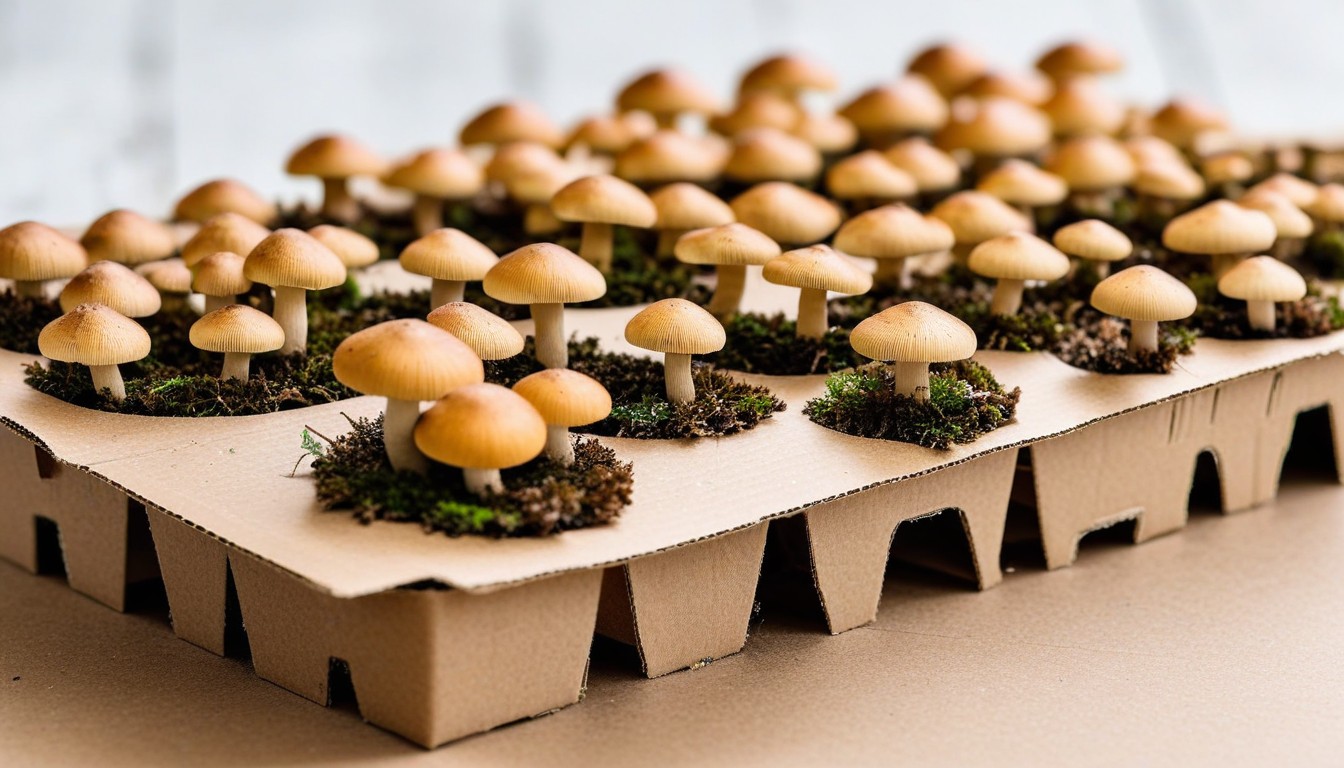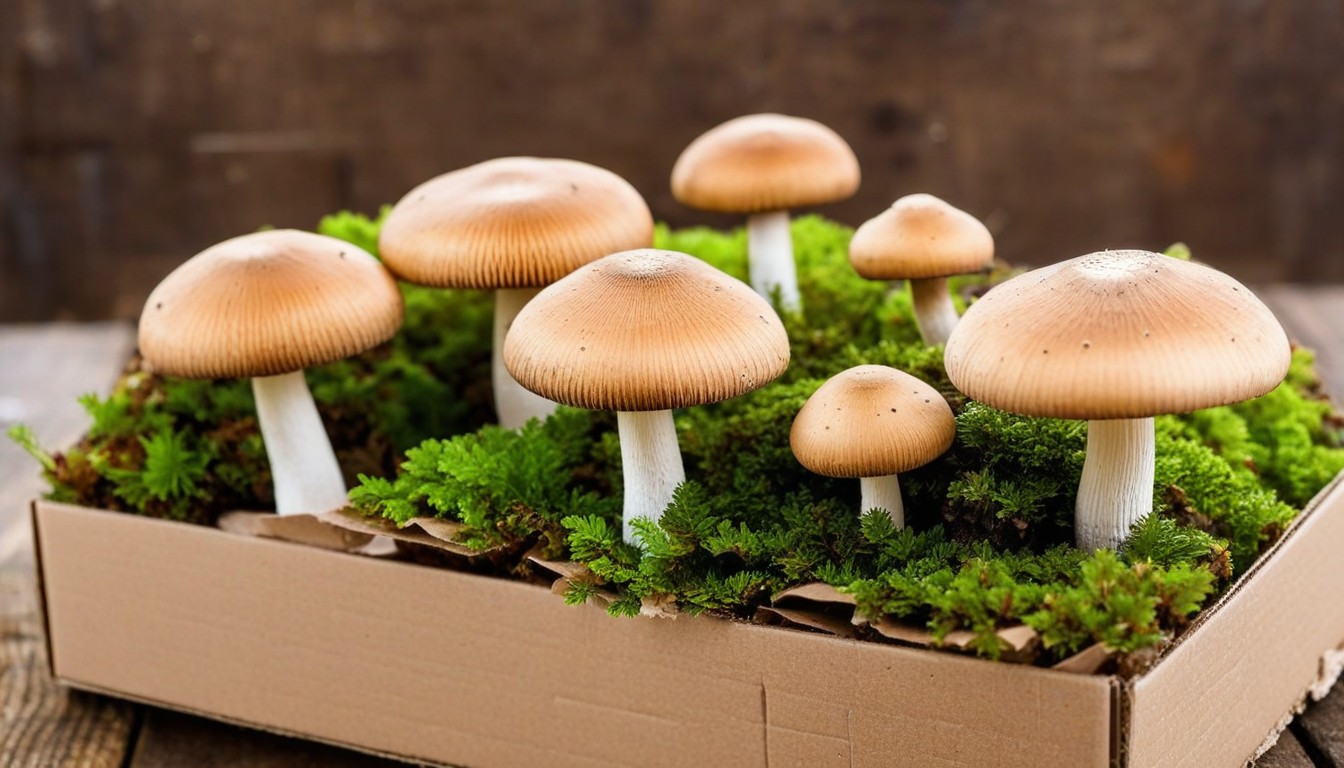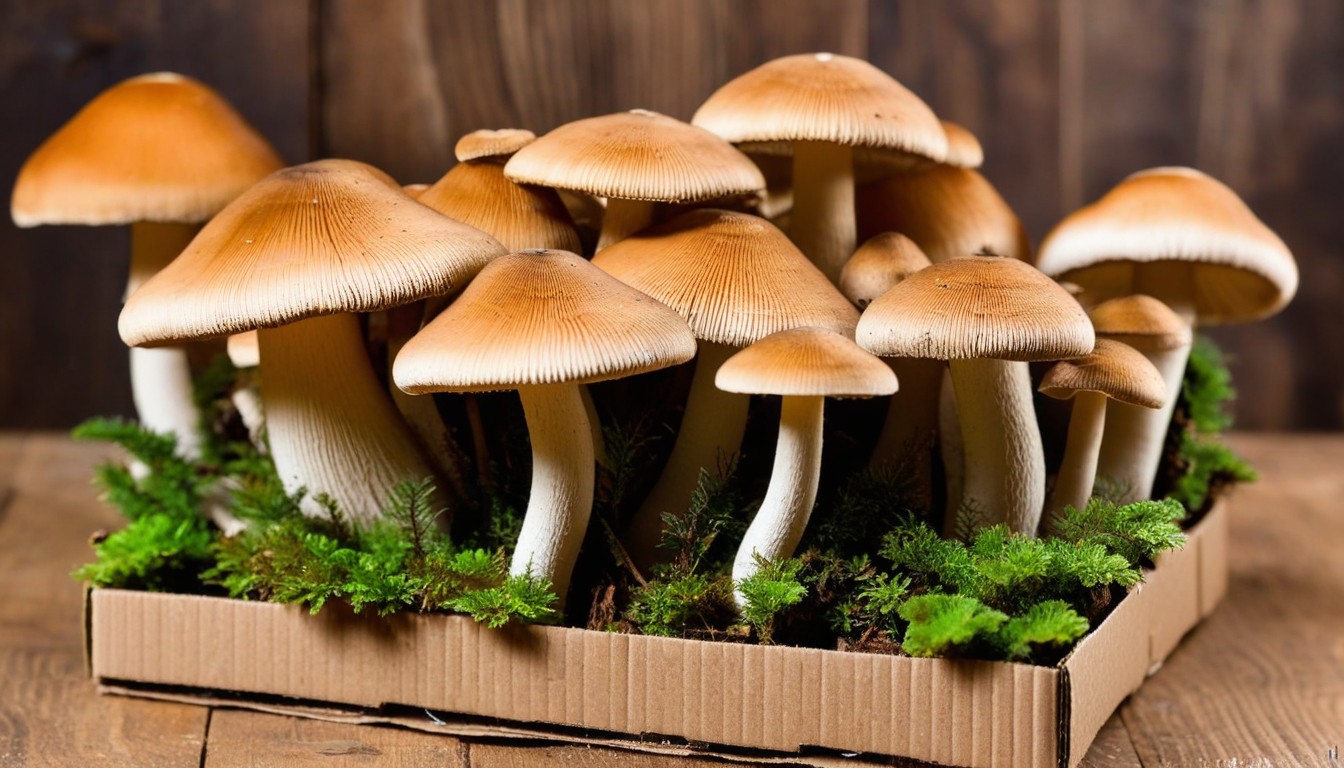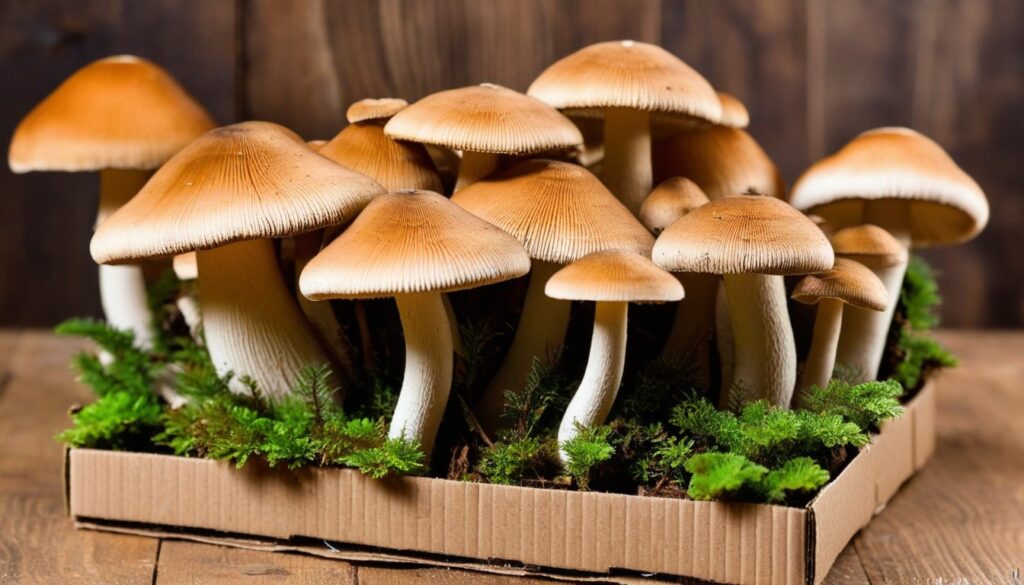Welcome to our comprehensive guide on growing mushrooms on cardboard at home. If you are looking for a rewarding and sustainable hobby that produces delicious results, you’ve come to the right place. Home cultivation of mushrooms on cardboard is an easy and accessible way to create your own edible garden, and it requires minimal resources to get started.
In this guide, we’ll walk you through the steps of growing mushrooms on cardboard from start to finish. We’ll cover everything from choosing the right mushroom species and preparing the cardboard substrate to creating the ideal growing conditions and monitoring your mushrooms’ growth.
By the end of this guide, you’ll have all the knowledge and tools necessary to cultivate your own batch of fresh, homegrown mushrooms. Whether you’re a seasoned gardener or just starting, this guide is perfect for anyone interested in exploring the world of mushroom cultivation.
Key Takeaways
- Home cultivation of mushrooms on cardboard is an easy and accessible way to create your own edible garden.
- This guide will cover everything from choosing the right mushroom species and preparing the cardboard substrate, to creating the ideal growing conditions and monitoring your mushrooms’ growth.
- By the end of this guide, you’ll have all the knowledge and tools necessary to cultivate your own batch of fresh, homegrown mushrooms.
- Growing mushrooms on cardboard is a sustainable and rewarding hobby that requires minimal resources to get started.
- Whether you’re a seasoned gardener or just starting, this guide is perfect for anyone interested in exploring the world of mushroom cultivation.
Introduction to Growing Mushrooms
Are you curious about mushroom cultivation? Growing mushrooms at home is a fun and rewarding experience that offers numerous benefits. As more people are becoming interested in sustainable gardening, growing mushrooms on cardboard is becoming increasingly popular. In this section, we’ll explore mushroom cultivation and the advantages of growing mushrooms.
Mushroom Cultivation
Mushroom cultivation involves the controlled growth of edible and medicinal mushrooms. Cultivating mushrooms can be done in a variety of ways, including using mushroom spawn, grain, sawdust, compost, and even cardboard. Growing mushrooms on cardboard is a simple and affordable method that requires minimal space and equipment.
The Benefits of Growing Mushrooms
There are numerous benefits to growing mushrooms at home. One of the most significant benefits is the nutritional value they offer. Mushrooms are low in calories and high in nutrients, including antioxidants, B vitamins, and vitamin D. Additionally, growing mushrooms is a sustainable practice that can help reduce waste by utilizing upcycled materials such as cardboard. Cultivating your own mushrooms also affords you the peace of mind of knowing the exact source and quality of the food you consume.
Sustainability
Mushroom cultivation is a sustainable practice that can help reduce waste and support a healthier ecosystem. Mushrooms can be grown on a variety of substrates, including agricultural waste, like straw and sawdust, and even cardboard. This means that rather than discarding these materials, they can be upcycled to produce food. Growing your own food, like mushrooms on cardboard, promotes food self-sufficiency and reduces the carbon footprint of food transport.
“Mushroom cultivation is a sustainable practice that can help reduce waste and support a healthier ecosystem. Growing your own food, like mushrooms on cardboard, promotes food self-sufficiency and reduces the carbon footprint of food transport.”
Choosing the Right Mushroom Species
Before you start growing mushrooms on cardboard, it’s essential to choose the right species that suit your growing preferences and goals. Here are some edible mushroom varieties that are well suited for cardboard cultivation:
|
Mushroom Species |
Growing Preferences |
Description |
|---|---|---|
|
Shiitake |
Temperature: 59–86°F Humidity: 80–90% Light: Indirect sunlight or artificial light |
Shiitake mushrooms are one of the most popular varieties in culinary dishes. They are rich in umami flavor and have a meaty texture. |
|
Oyster |
Temperature: 65–75°F Humidity: 80–90% Light: Indirect sunlight or artificial light |
Oyster mushrooms are easy to grow and produce abundant yields. They have a delicate flavor and a velvety texture, making them perfect for stir-fries and soups. |
|
Lion’s Mane |
Temperature: 60–75°F Humidity: 85–95% Light: Indirect sunlight or artificial light |
Lion’s Mane mushrooms have a unique appearance and flavor. They taste similar to seafood and have a stringy texture, making them an excellent meat substitute in vegetarian dishes. |
Remember that different mushroom species have specific growing preferences. Research each species in depth to ensure a successful harvest. Once you’ve selected your desired mushroom, it’s time to move on to preparing the cardboard substrate.
Preparing the Cardboard Substrate for Mushroom Cultivation

Preparing the cardboard substrate is a vital step to ensure successful mushroom cultivation. The substrate, or growing medium, provides the necessary nutrients and structure for the mushrooms to grow and develop.
Choosing the Right Cardboard
When selecting cardboard for your substrate, it’s crucial to choose non-glossy, plain cardboard with no added chemicals or inks. Remove any tape, staples, or other non-cardboard materials before use.
Breaking Down the Cardboard
Once you have selected your cardboard, you will need to break it down into small pieces. This can be done by hand or with a cardboard shredder.
Sterilizing the Cardboard
Before using the cardboard as a growing substrate, it’s important to sterilize it to remove any potential contaminants. There are several methods for sterilizing cardboard, including:
- Boiling: Boil the cardboard in water for 30 minutes.
- Baking: Bake the cardboard in the oven at 180°C for 30-45 minutes.
- Microwaving: Microwave the cardboard for 5-10 minutes, flipping it every 2 minutes.
Make sure the cardboard cools to room temperature before using it as a substrate.
Preparing the Cardboard

Once the cardboard is sterilized, it’s ready to be prepared for mushroom cultivation. Soak the cardboard pieces in water for 12-24 hours, then drain off any excess water. You can then layer the pieces in a container, adding mushroom spawn between the layers.
It’s essential to ensure that the cardboard is at the right moisture level. Squeeze a handful of cardboard to check the moisture level – it should be damp but not soaking wet.
Now that your cardboard substrate is prepared and sterilized, it’s time to inoculate it with mushroom spawn. Head over to our section on Inoculating the Cardboard to learn more.
Inoculating the Cardboard
Now that your cardboard substrate is prepared, it’s time to inoculate it with mushroom spawn. Mushroom spawn is a mixture of mycelium and other organic materials that serves as the starting point for mushroom growth.
You can either purchase mushroom spawn or make your own. If you’re making your own spawn, you’ll need to first grow mycelium on a substrate like grain or sawdust. Once you have your spawn ready, you can begin the inoculation process.
To inoculate your cardboard, begin by breaking apart the spawn into small pieces. Then, spread the pieces evenly over your cardboard, ensuring that they are well dispersed.
Once the spawn is spread out, use a rolling pin to press it firmly into the cardboard. This will help the mycelium grow more easily into the cardboard.
Finally, cover the inoculated cardboard with a layer of damp newspaper or paper towels to keep the moisture levels consistent.
Mycelium Growth
After inoculation, the mycelium will begin to grow throughout the cardboard substrate. Mycelium is the vegetative part of the fungus, and it serves as the network of cells that will eventually give rise to the mushrooms themselves.
You should begin to see visible signs of mycelium growth within a few days of inoculation. The mycelium will appear as white, web-like strands that spread throughout the cardboard substrate.
As the mycelium grows, it will continue to break down the cardboard and transform it into a medium that is suitable for mushroom fruiting.
Tips for Successful Inoculation
- Use fresh, high-quality mushroom spawn for the best results.
- Make sure to sterilize your tools and work area to prevent contamination.
- Spread the spawn evenly over the cardboard substrate to ensure even colonization.
- Press the spawn firmly into the cardboard to encourage mycelium growth.
- Keep the inoculated cardboard moist and covered to maintain optimal growing conditions.
Creating the Ideal Growing Conditions

Creating ideal growing conditions is crucial for a successful mushroom cultivation. Mushrooms require specific temperature, humidity, and light exposure for optimal growth.
Temperature
The temperature range for growing mushrooms on cardboard is between 60°F and 75°F (15.5°C and 23.8°C).
Keeping the temperature within this range is essential for healthy growth. Too low or too high temperatures can lead to slow growth, or even contaminated growth.
Ensure a consistent temperature in the growing area by using a thermometer or thermostat. Keep the area of cultivation in a room with stable temperature, free from drafts and direct sunlight.
Humidity
Humidity is the measure of moisture in the air. Mushrooms thrive in a humid environment with a range between 75% and 85%.
To maintain ideal humidity levels, mist the cardboard substrate regularly with a spray bottle. The frequency of misting will depend on the conditions of your growing area.
If the air is too dry, you can use a humidifier to maintain the humidity levels.
Light
Light is not essential for mushroom growth, but it can have an impact on the fruiting process and quality of the mushrooms.
Mushrooms require indirect light exposure, and they should not be exposed to direct sunlight. The best light conditions for mushrooms are 12 hours of light and 12 hours of darkness in a day.
Note: Mushroom growth can be affected by changes in the environment. Keep a record of the temperature, humidity, and light exposure to monitor the conditions and make adjustments as necessary.
Maintaining Proper Moisture Levels
Moisture control is vital to ensure the success of your mushroom cultivation. The right amount of moisture in the air allows your mushrooms to grow and thrive. Too little moisture can cause your mushrooms to dry out, while too much moisture can lead to mold growth and rot.
Effective Techniques for Moisture Control
To maintain proper moisture levels for your mushroom cultivation, here are some effective techniques:
- Misting: Misting your mushrooms with a spray bottle is a great way to control the amount of moisture in the air. Use a fine mist setting and spray around the growing area several times a day, keeping the mushrooms moist but not saturated.
- Humidity Maintenance: To keep the air moist around your mushrooms, you can use a humidifier to add moisture to the air. Alternatively, you can place a tray of water near your growing area to increase humidity levels.
Maintaining Proper Moisture Levels in Different Growing Stages
It’s essential to maintain proper moisture levels throughout all stages of mushroom growth. Here are some tips for maintaining moisture levels during different stages:
|
Stage |
Moisture Levels |
|---|---|
|
Inoculation |
Keep the cardboard moist but not wet. Mist the area around the cardboard and the cardboard itself once daily. |
|
Mycelium growth |
Maintain high humidity levels of around 80-90%. Mist the area around the mushrooms several times a day to maintain moisture levels. |
|
Fruiting |
Gradually lower the humidity to around 70-75% and mist around the mushrooms several times a day. Be careful not to over mist as this can lead to mold growth. |
By using these moisture control techniques, you can ensure that your mushrooms grow and thrive in the best possible environment.
Controlling Contaminants

The key to a successful mushroom cultivation process is ensuring a sterile growing environment. Contaminants can pose a threat to your mushroom mycelium, and even a small amount can ruin an entire batch. Here are some contaminant prevention practices to keep your mushroom cultivation healthy:
- Sterilization Methods: Before starting the cultivation process, it’s important to sterilize all the equipment you will use. This includes the container, scissors, and even your hands. You can use rubbing alcohol or a bleach solution to sterilize these items.
- Hygiene Practices: While you’re working on the mushroom cultivation process, make sure to wash your hands frequently. Avoid doing anything that could introduce contaminates to your growing environment. Be careful not to sneeze, cough, or breathe above the mycelium.
Despite these preventative measures, contaminants may still find their way into your growing environment. Here are some signs to look out for:
“If you notice an unusual odor, mold growth, or discoloration on your mycelium, it may be contaminated.”
If you do notice a contamination issue, act quickly to minimize damage. Here are some steps you can take:
- Remove the Contaminant: Use a sterilized tool to remove the contaminated area as soon as possible.
- Isolate the Contaminated Area: Separate the contaminated area from your healthy mycelium by placing a physical barrier between them.
- Re-Sterilize the Area: Sterilize the area surrounding the contaminated spot to prevent the contamination from spreading.
By following these contaminant prevention and control techniques, you can ensure the successful growth of your mushrooms. Happy cultivating!
Monitoring Mushroom Growth
As your mushrooms start to grow, it’s time to begin monitoring their progress. This stage is crucial for ensuring optimal growth and a bountiful harvest.
Growth Monitoring
One of the key aspects of monitoring mushroom growth is tracking mycelium colonization. Mycelium is the vegetative part of the mushroom and is responsible for nutrient absorption and growth. As the mycelium colonizes the cardboard, it will become more visible and dense, indicating healthy growth.
It’s also important to monitor the fruiting conditions, including temperature, humidity, and light exposure. These factors can significantly impact the growth and development of your mushrooms.
Mycelium Colonization
Monitoring mycelium colonization involves observing the growth and spread of the mycelium throughout the cardboard substrate. This can be done by visually inspecting the cardboard or using a sterile tool to gently scrape the surface and examine the mycelium growth.
Once the mycelium has colonized the cardboard, it’s time to introduce fruiting conditions to promote the growth of the actual mushrooms.
Fruiting Conditions
Creating optimal fruiting conditions is essential for a successful mushroom harvest. This involves maintaining a temperature range of 60-70°F and a relative humidity of 90-95%.
Light also plays a role in mushroom development. While mushrooms don’t require direct light, they do need some exposure to trigger the formation of fruiting bodies. Indirect natural light or low-intensity artificial light can be used to promote this process.
By monitoring these growth factors closely and making adjustments as needed, you can ensure a healthy and bountiful harvest of delicious homegrown mushrooms.
Harvesting and Enjoying Your Mushrooms
Harvesting your homegrown mushrooms is a satisfying and fulfilling experience. Here are some tips to ensure a successful harvest:
Timing
It’s important to harvest your mushrooms at the right time. For most varieties, this is when the caps fully expand but before they begin to flatten out. If you wait too long, the mushrooms may become overripe and drop their spores, leading to a less desirable texture and flavor.
Preservation
After harvesting, it’s best to consume or preserve your mushrooms within a few days. One preservation method is to dry your mushrooms by hanging them upside down in a dry, well-ventilated area. You can also store them in the fridge or freezer for later use.
Culinary Uses
Mushrooms are a versatile ingredient in the kitchen and can be used in a variety of dishes. Whether sautéed, grilled, or roasted, their unique umami flavor adds depth and complexity to any recipe. Consider using your homegrown mushrooms in a savory omelet or adding them as a topping to a homemade pizza.
Troubleshooting Common Issues
As with any gardening endeavor, challenges may arise during your mushroom cultivation journey. While frustrating, these obstacles are an opportunity to learn and improve your technique. By identifying common problems and their solutions, you can avoid potential pitfalls and enjoy a successful harvest. Here are a few of the most frequent issues:
Problem: Contaminants in the Substrate
Contaminants such as bacteria or mold can infect your cardboard substrate and compete with your mushrooms, causing stunted growth or even complete failure. Common causes include poor sterilization techniques or using contaminated materials.
Solution: Take extra care when sterilizing your materials and use a high-quality mushroom spawn. Additionally, keep your growing environment clean and free of potential contaminants, such as pet hair or soil.
Problem: Dry or Wet Growing Environment
Mushrooms require a specific balance of moisture to thrive. If the growing environment is too dry, your mushrooms may not grow at all, while an overly wet environment can promote mold growth or cause your mushrooms to rot.
Solution: Maintain proper moisture levels by misting your growing area regularly and monitoring humidity levels. Avoid overwatering and ensure proper drainage in your substrate.
Problem: Poor Fruiting Conditions
If your mushrooms are not fruiting properly, it may be due to inadequate light or improper temperature conditions.
Solution: Ensure that your growing area has ample light, but avoid exposing your mushrooms to direct sunlight. Monitor temperature levels, which should be between 60-75°F (15-24°C) for most varieties.
By addressing these common issues and staying vigilant in your growing efforts, you can enjoy a successful mushroom cultivation experience. Don’t be discouraged by setbacks – they are simply opportunities to learn and improve your technique. Happy growing!
Conclusion
In conclusion, growing mushrooms on cardboard at home is an enjoyable and rewarding experience. It’s a great way to cultivate your own edible garden and experience the joy of harvesting fresh mushrooms.
We hope our easy guide has provided you with the knowledge and confidence to embark on your own mushroom cultivation journey. Remember to choose the right mushroom species, prepare the cardboard substrate properly, create the ideal growing conditions, maintain proper moisture levels, and control contaminants.
Happy Mushroom Growing!
With our expert tips and tricks, you can now successfully grow your own mushrooms at home. Enjoy the fruits of your labor by harvesting your mushrooms at the right time and trying out various culinary recipes. Don’t forget to share your experience with your friends and family!
Troubleshooting Tips
If you encounter any challenges during your mushroom cultivation journey, don’t worry! Common issues such as mold, pests, or slow growth can be overcome with diligence and patience. Refer to our troubleshooting section for practical solutions to these problems.
Once again, we wish you all the best in your mushroom growing venture. Happy cultivating!
FAQ
What are the benefits of growing mushrooms on cardboard at home?
Growing mushrooms at home allows you to enjoy the nutritional value of fresh mushrooms, promotes sustainability, and provides the satisfaction of cultivating your own food.
How do I choose the right mushroom species for growing on cardboard?
It’s important to consider the growing preferences of different mushroom species. Research edible varieties and their requirements to ensure successful cultivation on cardboard.
How do I prepare the cardboard substrate for mushroom growth?
Properly preparing the cardboard substrate involves sterilization techniques to create an optimal environment for mushroom colonization.
What is the process of inoculating the cardboard with mushroom spawn?
Inoculating the cardboard involves introducing mushroom spawn to promote mycelium growth and colonization of the substrate.
What are the ideal growing conditions for mushrooms on cardboard?
Mushrooms thrive in specific environmental conditions. You’ll need to consider factors such as temperature, humidity, and light exposure for optimal growth.
How do I maintain proper moisture levels for mushroom cultivation?
Proper moisture control is essential. Learn techniques like misting and humidity maintenance to prevent dry or overly moist conditions that can hinder mushroom growth.
How can I control contaminants during mushroom cultivation?
Contaminants can be a challenge. Explore methods such as sterilization and hygiene practices to effectively control contaminants and maintain a healthy growing environment.
How do I monitor the growth of my mushrooms?
Monitoring mushroom growth involves tracking mycelium colonization, recognizing signs of healthy growth, and creating optimal fruiting conditions for a successful harvest.
What are the best practices for harvesting and enjoying homegrown mushrooms?
Harvest mushrooms at their peak, learn about preservation methods, and explore the various culinary uses to fully enjoy your homegrown harvest.
What should I do if I encounter common issues during mushroom cultivation?
Troubleshooting common issues is part of the journey. Explore practical solutions to overcome challenges and ensure a successful and rewarding mushroom cultivation experience.

